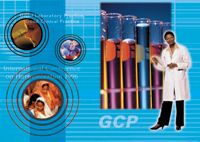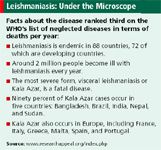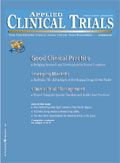Building Research Capacity into Drug Development
Applied Clinical Trials
A collaborative model for increasing drug availability in resource-poor, disease-endemic countries
Leishmaniasis ranks third on the World Health Organization's (WHO) list of neglected diseases in terms of deaths per year. It is estimated that 350 million people are at risk. When untreated, death occurs within two years of infection. In the mid-1990s, physicians in Bihar, India, encountered antimonial resistant parasites and began looking for alternative treatments. At that time, miltefosine had been shown to have activity against leishmania in vitro and in animal models. Developing miltefosine for the treatment of visceral leishmaniasis (VL), or Kala Azar, was attractive, but the cost of clinical development would be high. Since the disease is primarily present in poorer communities in developing countries, a pharmaceutical company would find it difficult to make a return on investment on such a drug. However, one company was interested in partnering with other health-related organizations to bring miltefosine to market for the treatment of VL.

In 1995, the Special Programme for Research and Training in Tropical Diseases (TDR) agreed to collaborate with Asta Medica (now known as Zentaris), the company that originally discovered the drug, in the development of miltefosine for VL. The compound was assessed and incorporated into TDR's development portfolio. In 1998, in collaboration with scientists in India, the government of India (Indian Council for Medical Research, ICMR), and the private sector (Asta Medica), TDR initiated a Phase II clinical trial of miltefosine for VL in Bihar, India.
Model of collaboration
TDR shared the cost with the company for the clinical development of miltefosine. A memorandum of understanding (MOU) was drawn up between TDR and Asta Medica (Zentaris) to ensure the availability and affordability of the drug in endemic countries if it proved to be safe and effective. A public–private partnership model was developed for this project. The model involved substantial participation of the Indian investigators as well as ICMR and the Indian Kala Azar control program. As the project neared the culmination of the Phase III clinical trial, the involvement of the Indian Kala Azar control program increased.

Leishmaniasis: Under the Microscope
After drug registration in India, ICMR took the leadership role in organizing the Phase IV study in India and Nepal. TDR played a supporting role, mainly involved with capacity building at the study sites and setting up central laboratories to support the Phase IV study. Once the Phase IV study was completed, TDR's leadership role in the project was transferred to WHO's Southeast Asia Regional Office (SEARO). SEARO had the advantage of closer regional ties with control programs in disease endemic Nepal, Bangladesh, and India.
Early beginnings
To start the project, TDR set up a product development team (PDT), a small team of experts from India, Europe, and the United States. The role of the PDT was to direct the development strategies and oversee the progress of the study. According to already established TDR policy, all clinical studies receiving TDR support must be carried out according to international best practices standards, including Good Laboratory Practice (GLP), Good Clinical Practice (GCP)1,2 and—more recently—Good Ethical Review Practice.3
Although these requirements are easily said, adherence is less easy, particularly by large governmental agencies.
Capacity building
Ready for the pivotal clinical trial in adult patients, all investigators were trained in the principles of GCP, the ethics of clinical research, and all the procedures required by the protocol. TDR required that the investigators demonstrate an understanding of GCP as well as a practical capacity to implement GCP in terms of the protocol. Adherence to international GCP standards and the Declaration of Helsinki4 (World Medical Association, 1964) were crucial since the objective of the project was to register the drug for treatment of VL.
The introduction of strict GCP proved challenging for the investigators. It involved a new system and a new working environment. All personnel involved in the trial were trained for their roles and responsibilities. The principle investigator of each trial site needed to understand that he/she had overall responsibility for all activities at the study site. Much of the paperwork involved was felt at first by the investigators to be unnecessary and bothersome for day-to-day work in the clinic. Through training and practical experiences with the new system, investigators relaxed and adapted to working according to GCP principles.
As part of the effort to comply with GCP guidelines, TDR introduced clinical trial monitors into the study. Clinical trial monitors played a crucial role in the study, providing oversight and direction during the conduct of the research. TDR clinical trial monitors are physicians and scientists trained in research and GCP prior to joining the team. Before participating in the trial, they were trained on the specific protocol, including all the procedures and requirements of the protocol, so that they could assist the investigator in solving the problems that occurred at the study sites. They also assisted the investigators in setting up standard operating procedures (SOPs) for the conduct of the study to ensure the smooth running of activities at the study sites. They reviewed and verified the data to ensure both the existence and quality of the source data. They provided additional assurance to TDR that the study was in compliance with GCP requirements.
The clinical monitors visited the study sites monthly to validate compliance with GCP. Routine audits were performed at all study sites. These helped TDR to ensure that the data generated at the clinical trial sites were of adequate quality. Should the drug then prove to be safe (well tolerated) and effective, it could be registered in India and elsewhere, including Germany, where the sponsor company is situated.
The laboratory that supported the clinical trial was trained in the principles of GLP. Quality control and assurance were implemented in this laboratory. The readings of the parasite slides were very important for the study, as these readings provided the parameter by which efficacy was evaluated. The accuracy of the reading was crucial. TDR, in collaboration with Zentaris, arranged for 10% of the parasite slides to be read at the end of the trial by an independent expert designated by the ICMR. When there were discrepancies between the readings, face-to-face meetings were arranged between the independent expert and the laboratory to discuss and resolve the discrepancies. This arrangement contributed to the overall capacity building of the laboratory.
Sustainability of the capacity
The Phase II and III clinical studies in adult patients were performed entirely in private clinics. This may not be sustainable in the long run. TDR felt that more capacity building needed to be done in terms of sustainability of clinical research in this region of India. It was clear that ICMR's Kala Azar research institution in Patna (RMRI) was an ideal place to achieve this.
TDR sent a team to assess RMRI's capacity as a GCP clinical trial site. The team identified several areas that needed to be improved, including its laboratory, the capacity and motivation of the staff for doing research, and its ethical review system. TDR had a discussion with the Director General of ICMR, Professor N.K. Ganguly, on the collaborative efforts needed to bring the quality of research done in this institution to international levels of good research practice. ICMR agreed to provide funding to support the improved infrastructures identified by TDR, which was responsible for assisting the institution in team building and technology transfer.
TDR funded the director of RMRI, Dr. Sujit Bhattacharya, to visit a research institution in Bangkok, Thailand, and participate in a course on ethical review in biomedical research. Upon his return, Dr. Bhattacharya revised his ethics committee function by implementing WHO Operational guidelines for ethics committees that review biomedical research.
A series of workshops for laboratory staff was held on writing SOPs. After the renovation of the institution and the retraining of all staff, the TDR team went back to the site to make another assessment. It appeared that the staff had become more motivated, the RMRI–ICMR research institution in Patna was revived, and the site was ready to perform clinical trials compliant with GCP. As a result of these efforts, RMRI was selected in 2001 as one of the study sites for carrying out the miltefosine pivotal trial for pediatric patients.
Expansion of the capacity building
Even after the registration of miltefosine in India in early 2003, the Indian control program was concerned about patient compliance with the treatment regiment in the field. The treatment course requires 28 days to achieve reliable efficacy. The challenge was to ensure a method for outpatient compliance. All of the clinical studies so far, in both adults and children, involved only in-patient care. Thus, patient compliance to the treatment regiment was easier to control and verify.
The control program requested that the Phase IV study be carried out to answer the compliance issue and to gain more safety data before using the drug in a control program, where less supervision would be available. At this time, RMRI in Patna had enough confidence to lead the Phase IV study.
ICMR provided funding for the study, and requested that TDR assist RMRI with the assessment of study sites, the training of investigators, the increase of local laboratory capacities to support a Phase IV trial, and the provision of clinical trial monitors for the study. Zentaris was asked to support RMRI with the data management. Under the leadership of the RMRI team, more than 20 private clinics in Bihar were screened as possible sites for a Phase IV study, of which 15 were selected. More than 10 labs were assessed and five were selected to participate in the trial. Six months after the initiation of the study in Bihar, one additional site in Nepal was included.
After site selection, RMRI arranged investigator meetings to discuss the Phase IV protocol and GCP training for all investigators. GLP training was done in parallel with the GCP training. All training was done at RMRI under the leadership of RMRI staff and with assistance from TDR.
The integration of GCP into existing practice in private clinics proved to be a daunting task. It demanded considerable interaction between RMRI and the centers, as well as coordination between the laboratories and the clinics. The trial was monitored by the TDR clinical trial monitoring team.
TDR asked that a laboratory team from Bangkok, led by Professor Kesara Na-Bangchang, assist RMRI in setting up several laboratories for the Phase IV work in order to improve operations under field conditions. The selected laboratories were trained in GLP. The methodologies in the laboratory required by the study were harmonized across the five laboratories. A workshop on writing SOPs took place at RMRI; to ensure the integration of the SOP into actual practice, a follow-up was performed at each laboratory by a team from RMRI and Bangkok at both one-and three-month intervals after the initial training.
Every laboratory worked according to the same standard operating procedures, with the exception of a few modifications based on the different needs of the laboratories—but always in compliance with the protocol. The monitoring of the quality of the laboratory performance was assessed at intervals by the TDR clinical trial monitors.
The Phase IV study was completed with satisfactory results. The results were presented to the Bangladesh, Indian, and Nepal national control programs at a meeting organized by SEARO in December 2004. RMRI now has the capacity not only to carry out GCP clinical trials, but also to coordinate GCP trials in areas with difficult environments and limited medical resources.
Direct impact
Having been informed about the design, capacity-building initiatives, and progress in the development of the miltefosine project, SEARO initiated the Kala Azar elimination program with the aim of eliminating Kala Azar from the Indian subcontinent by the year 2015.5 The program involves the full engagement of the control programs of the three countries, Bangladesh, India, and Nepal. The program is now considering miltefosine for its first-line drug treatment.
Conclusion
The development of miltefosine served both missions of TDR: to develop new tools for neglected infectious diseases and to build research capacity in disease endemic countries. Good collaboration between the private and public sectors along with smooth transference of leadership at each stage of development were important milestones throughout the project.
The goal of TDR, when engaged in the development of miltefosine, was to have an oral drug that is effective, well tolerated by patients, accepted by the communities, and integrated into the control programs of the disease-endemic countries. The capacity building that was part of the development process, which lead to data of good quality, ensured human subject protection and provided a strong basis for the registration of the drug in both India and Germany. Beyond drug registration, the development model described here also lead to national implementation programs for disease control and eventual elimination according to a model of drug availability and affordability in resource-poor settings.
The experience from this project suggests that early involvement of local researchers, local research institutions, and the local government (the control program) can create a smooth interface between research and implementation. Beyond this, there is a direct impact on public health in the region as well as an increased capacity for the region to address more directly its own health challenges in the future.
Acknowledgement
The authors wish to express their appreciation to Francis P. Crawley of the Good Clinical Practice Alliance—Europe and Professor Win Gutteridge, TDR Consultant, for their critical remarks during the drafting of this article.
J. Karbwang* is clinical coordinator with the Special Programme for Research and Training in Tropical Diseases (TDR), The World Health Organization, 20 Avenue Appie, CH-1211 Geneva, Switzerland, email: karbwangj@who.int. N.K. Ganguly is with the Indian Council of Medical Research, Ansari Nagar, New Delhi 110029, India.
References
1. International Conference on Harmonization (ICH) of Technical Requirements for the Registration of Pharmaceuticals for Human Use (ICH), 1996. Note for Guidance on Good Clinical Practice. 1 May 1996 (http://www.ich.org/ich5e.html#GCP).
2. World Health Organization (WHO), Guidelines for Good Clinical Practice (GCP) for Trials on Pharmaceutical Products. Annex 3 of The Use of Essential Drugs. Sixth Report of the WHO Expert Committee. Geneva: World Health Organization, 1995, 97–137.
3. World Health Organization (TDR/WHO), Operational Guidelines for Ethics Committees that Review Biomedical Research. Geneva: WHO, 2000 (http://www.who.int/tdr/publications/publications/ethics.htm).
4. World Medical Association, 1964. Declaration of Helsinki: Ethical Principles for Research Involving Human Subjects. Adopted by the 18th World Medical Assembly, Helsinki, Finland, June 1964. Amended by the 29th World Medical Assembly, Tokyo, Japan, October 1975; the 35th World Medical Assembly, Venice, Italy, October 1983; the 41st World Medical Assembly, Hong Kong, September 1989; the 48th General Assembly, Somerset West, Republic of South Africa, October 1996; the 52nd General Assembly, Edinburgh, Scotland, October 2000; Washington 2002; and Tokyo 2004 (http://www.wma.net/e/policy/b3.htm)
5. World Health Organization, Elimination of Visceral Leishmaniasis: Report of an Intercountry Informal Consultative Meeting, Varanasi, India; 10–14 November 2003. WHO Regional Office for Southeast Asia, 2004, SEA-VBC-84.
*To whom all correspondence should be addressed.

Improving Relationships and Diversifying the Site Selection Process
April 17th 2025In this episode of the Applied Clinical Trials Podcast, Liz Beatty, co-founder and chief strategy officer, Inato, discusses a number of topics around site engagement including community-based sites, the role of technology in improving site/sponsor relationships, how increased operational costs are impacting the industry, and more.